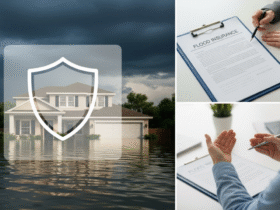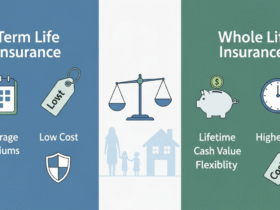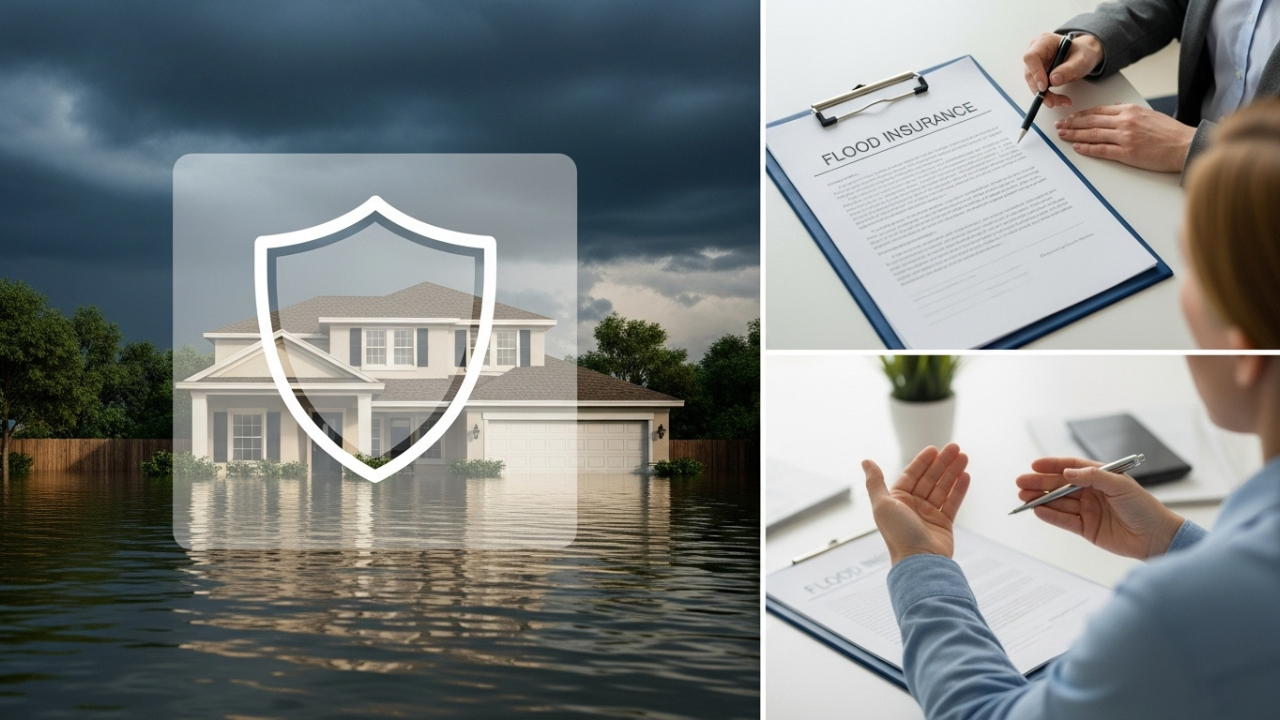Residing in areas susceptible to flooding poses significant challenges. Homeowners have to cope with the expensive and exhausting damage brought on by seasonal floods, hurricanes, or rising rivers. For these reasons, it is crucial to select optimal home insurance for such areas.
There are considerable gaps when it comes to covering flood damages. Based on my very own experience, not all forms of insurance fully cover floods, while others offer minimal aid when a disaster occurs. After resolving this, I’m ready to share valuable insights with you, so that together we can ensure that you, your family, and finances remain insured before the arrival of the next storm.
Let’s walk through the most important pointers to remember before we protect your home, family, and financial security.
Key Takeaways
- Standard home insurance does not cover flood damage.
- Adequate insurance for flood prone areas must include structure and contents insurance.
- Federal flood insurance (NFIP) is available to most people and comes with some limitations.
- Private flood insurance typically has higher limitations and faster payout options.
- A combination of home insurance with flood insurance leads to an optimized coverage strategy.
Why You Need Specialized Insurance in Flood Zones
If you live near the coast, riverbanks, or in states like Florida, Louisiana, or Texas, you are most likely aware of the risk of flooding. What you may not know is that your homeowners insurance policy will not cover the damage caused by floods.
This is the biggest blunder most homeowners commit. Flooding and water damage are treated and covered separately by insurers and not as one. The best form of home insurance in flood-prone areas is one that offers both home and flood insurance as a combined package.
Understanding the Importance of Specialized Flood Insurance
In flood-prone regions, it is essential to note that the conventional homeowners insurance policy you possess will most likely exclude flood-related damage entirely. This is why specialized flood insurance exists, to ensure that you are able to defend your property and possessions with precision.
Why Standard Homeowners Insurance Falls Short
Standard homeowners insurance covers the damage or loss of your home and possessions due to fire, theft, wind storms, among other perils. This insurance does not cover the damage caused by flood waters which may stem from heavy downpours, storm surges, or rapid snow melts. Without specialized flood insurance, homeowners are left to shoulder heavy financial burdens due to inadequate coverage.
The Role of Flood Insurance
Flood insurance helps mitigate financial emergencies by covering losses from floods and flood-related erosion due to excessive water movement beyond expected cyclical levels. This type of coverage is necessary for homeowners living in potential hazard zones to reduce their losses and improve recovery efforts.
Types of Flood Insurance Policies
This list is non-exhaustive but helps equip clients with the necessary knowledge to select appropriate policies and insurance providers to adequately safeguard their homes and businesses.
1. National Flood Insurance Program (NFIP)
The Federal Emergency Management Agency (FEMA) National Flood Insurance Program (NFIP) provides insurance policies for homeowners, renters, and businesses within participating communities. These policies cover the structure and contents of a property subject to limitations and exclusions.
- Coverage Limits under NFIP
- Building Property Coverage: Up to $250,000
- Personal Property Coverage: Up to $100,000
These limits are widely recognized as inadequate for high value properties requiring additional policies which significantly curtail risks linked to over insurance.
2. Private Flood Insurance
Compared to NFIP policies, private insurers’ flood insurance policies may offer greater flexibility in terms of coverage limits and offer higher flexibility, including. These policies might offer added benefits such as:
- Higher Coverage Limits: Some private insurers offer dwelling coverage up to 4millionandcontentsinsuranceup500,000.
- Additional Living Expenses: Coverage for temporary housing if your residence is made uninhabitable due to flooding.
- Faster Claims Processing: Settling claims may be faster than NFIP policies.
People who would benefit from private flood insurance the most are homeowners with properties that exceed NFIP coverage limits or those seeking more comprehensive protection.
Evaluating the Best Home Insurance for Flood-Prone Areas
Taking out home insurance in flood-prone regions requires several considerations so as to enable households to have a complete cover and also achieve mental calmness.
Key Factors to Consider
- Coverage Limits: Check if the limits of covering the house and possessions also provide payment within the range of exact value of the property and its contents.
- Premium Costs: Make a comparison over a range of insurers to ensure selection of a cover which will be budget upholding.
- Deductibles: Appreciate the amount of deductible limits available and its bearing to the amount of expenditure one will incur in terms of co-payment for the claim.
- Claims Process: Determine how deep the company is in fulfilling its social responsibility on the claims paid; that is; whether they pay promptly and without undue delays and also at all.
- Additional Coverage Loss Prevention Options: Examine optional covers such as sewer backup, cleanup of rubbish and measures put aside for preventing floods.
Having explored these factors, you may select a cover that protects you better against flooding and related costs for damages.
Strategies to Lower Flood Insurance Premiums
There is no question that having flood insurance remains critical, however, keeping it while reducing how much one pays for premiums is also an option especially if the house is near water bodies.
1. Elevate Your Property
The base level at which flood insurance is issued. For those already insured by flood damages, lifting a hose above the base elevation flat can reduce insurance costs. Houses built on higher ground always tend to cheaper to put-up, and thus less exposed to flood damage, insured flood prone areas place insurance premiums.
2. Implement Flood Mitigation Measures
The implementation of preventive measures such as sump pumps, backflow valves, and flood gates can mitigate any type of prospective damage, making flooding far less likely to occur. These features can reduce risks of damages being incurred due to floods and may decrease insurance premiums as well.
3. Bundle Policies
A majority of companies offer the option to combine auto insurance, homeowners insurance, and even flood insurance, providing discounts on bundled policies. Doing this not only ensures the policyholder is covered on multiple levels, but also provides flood insurance, which can lead to monetary savings.
4. Shop Around
Always make sure to keep checking other insurers as well. Trying to obtain the lowest possible prices for the insurance you are acquiring would massively make a difference in ensuring you make the smartest decision with your money in terms of coverage.
Understanding the Claims Process
The process of claims is often long and tiring. In case a flood does occur, having knowledge of the claims process will optimize the chances of making the recovery process minute.
Steps to Take Immediately After a Flood
- Prioritize family and personal safety first: This means there’s no need to jump into floodwaters as well as listen to local warnings.
- Preserve Evidence: If damage has been made, he/she must obtain detailed photos as well as videos showcasing the loss of personal assets.
- Get in Contact with Relevant Companies: Staying informed with the given company ensures the claimant gets their money through the clearly stated process of getting paid for the services through a cleverly simple manner when documented properly.
- Take measures to stop further: By actively participating in trying to stop any further damages from occurring, such as getting rid of any excess water as well as locking up the premises which would make the chances of damage being able to occur lesser.
- Document Claim Files: As all the steps being proposed have a step that states keep making a log or report for all actions taken, claim files which include every communication with the insurer alongside documentation of how the recovery process works have now been termed claim files.
Working with Adjusters
The insurance adjuster performs an appraisal of your damages for purposes of determining the insurance payment. It will assist the adjuster if your documentation and records are neatly organized.
My Opinion
Finding the most ideal home insurance for areas that are susceptible to floods is essential to guarding your property and finances. Being well-acquainted with policy types, paying attention to evaluating important aspects, and taking measures to lower premiums will ensure appropriate coverage that is customized to your requirements. Take note that acting promptly, along with making well-informed decisions, will greatly improve your future.
For other inquiries or if you would like help in choosing an appropriate flood insurance policy, get in touch. Ensuring peace of mind is always a worthy investment.




























Leave a Reply